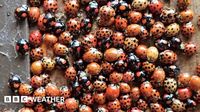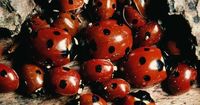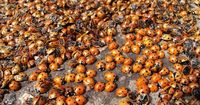Across the United Kingdom this week, an unexpected guest has been making itself at home—literally. Swarms of ladybirds, in numbers that have left some residents both fascinated and unnerved, have been spotted clustering on window sills, crawling through gaps in walls, and even taking over entire rooms. This sudden influx, widely reported on social media and confirmed by entomologists, is not just a quirky autumnal phenomenon but a reflection of deeper changes in the environment, the habits of invasive species, and the resilience of one of Britain’s most beloved insects.
On October 7, 2025, reports began pouring in from across the UK of unusual numbers of ladybirds swarming and clustering together in homes. According to inews, these ladybirds are seeking out sheltered spots for winter hibernation, a ritual they perform every autumn. However, experts point to warmer spring and summer temperatures as the main reason behind the surge in their numbers this year. Dr Dion Garrett, an entomologist at Rothamsted Research, explained, “What we’re seeing now is that the offspring of those adults have reproduced and survived in very good numbers. This is why we’re seeing the large numbers starting to find cracks and crevices over winter, in urbanised areas as well.”
The science behind the swarm is surprisingly straightforward. Ladybirds, like many insects, enter a state of dormancy known as diapause—a kind of insect hibernation—when the weather turns cold. Dr Elizabeth Duncan, professor of Zoology at the University of Leeds, told BBC News, “They huddle together to find shelter and stable conditions. Insects are ectothermic which means they can’t regulate their own body temperature and are dependent on their environment, so they need to find spots where they can stay insulated and avoid freezing.” In the wild, ladybirds typically hibernate in hollow trees or under bark and piles of leaves, but in urban areas, they’re increasingly finding refuge in houses, especially around loose-fitting windows and in the corners of bedrooms.
This year’s spectacle is also being shaped by the presence of an invasive species: the harlequin ladybird (Harmonia axyridis). First arriving in southeast England in 2003, the harlequin has since spread throughout nearly all of the UK. Dr Danny Haelewaters, lab head at the Biology Centre of the Czech Academy of Sciences, noted, “Sometimes you find five to 10 specimens [of harlequins], sometimes you find 100. They all crawl into each other or on top of each other.” Harlequins are slightly larger than native species, boasting a greater variety of colors, brown legs, and a distinctive white M-shaped marking behind their heads. Their tendency to congregate in larger groups than native ladybirds means they are often the ones being found in homes in such dramatic numbers.
Videos and photos of these ladybird invasions have flooded TikTok and other platforms. One user, @mummybossadventure, described the experience: “Did anyone else today get absolutely invaded by ladybirds? I turn round and within an hour there was just ladybirds absolutely everywhere. I love nature but this was just too much for me.” Another, @livvy.robertss, lamented, “I don’t mind if it’s just one ladybug and you let it crawl in your hand. But this many guys – this is a mass invasion!”
Despite the initial alarm, the reasons behind the ladybird boom are rooted in this year’s extraordinary weather. The Royal Horticultural Society reported a bumper season for insects, with aphids—the main food source for ladybirds—also booming thanks to the warmest and sunniest spring on record, followed by a summer with mean temperatures of 16.1°C, well above the long-term average. The resulting abundance of food allowed ladybirds to reproduce in record numbers, leading to the current autumn congregation as they seek winter shelter.
Yet the rise of the harlequin ladybird has not been without consequences. Within five years of their arrival, some native ladybird species had nearly halved in numbers, largely due to competition for food and predation by harlequin larvae. As Dr Haelewaters observed, “Even though some of these native ladybirds have decreased in populations, we are seeing some sort of equilibrium being reached right now. Its dominance isn’t going to reach 100 per cent, such that all the others are going to go away.” Dr Duncan echoed this, noting that harlequins tend to overwinter in homes, while native seven-spot ladybirds (Coccinella septempunctata) cluster in leaf litter outdoors.
The climate context cannot be ignored. As Dr Duncan explained to BBC News, “Ladybirds will be affected directly, through for example heat stress, potential changes to their winter dormancy and shifts in where they can survive, and also indirectly through changes in the timing, abundance, and types of food they feed on, particularly those that thrive on aphids.” In short, the ladybirds best equipped to handle extreme environments and a varied diet will fare best as the climate continues to shift.
For many residents, the sudden appearance of so many insects has sparked concern, not least about potential health risks. Some social media users worried about diseases, including sexually transmitted infections. Max Barclay, Senior Curator of Beetles at London’s Natural History Museum, clarified, “It is a fungus that forms little scales on the wing cases on the outside of the ladybird. You can actually see it with your naked eye and so can tell whether the ladybird is infected. It just looks like a yellow crust on some parts of the ladybird’s exoskeleton.” Thankfully, this fungus cannot be transmitted to humans—“We don’t have one of these, and we don’t have sex with ladybirds,” Barclay added, with a touch of humor.
So what should you do if your home becomes a ladybird hostel? The consensus among experts is clear: don’t panic, and don’t kill them. Dr Garrett advised, “They can be left alone and they will literally stay where they are. But if they are causing any issues, you can put them into a little box and just move them outside to a small shed or outbuilding or a sheltered area. They’re harmless, and they’re amazing for your garden.” Tom Hibbert from The Wildlife Trusts added, “Be good to ladybirds as they are both beautiful and the gardeners’ friend, keeping numbers of plant sucking bugs like aphids in check as they are voracious carnivores.”
Professor Tim Coulson, a biologist at the University of Oxford, summed up the ecological importance of these insects: “Predators, like ladybirds, are incredibly important components of ecosystems. Take away predators, and all hell breaks loose. We should cherish our ladybirds! Definitely do not kill the ladybirds as they keep the numbers of pest species down. Much better to have ladybirds than to spray crops with insecticides to kill the aphids.” Professor Helen Roy of the UK Centre for Ecology and Hydrology echoed this, urging, “If they have entered your home in large numbers, please do not harm them. Either leave the insects where they are if possible or, if they are in the way, gather them gently into a box and put them in an outbuilding.”
As autumn deepens and the weather turns, ladybirds—whether native or harlequin—are simply doing what they’ve always done: seeking shelter, surviving winter, and playing their part in Britain’s intricate ecological web. For those who find themselves sharing a home with these tiny beetles, a little understanding (and perhaps a gentle relocation) goes a long way.



